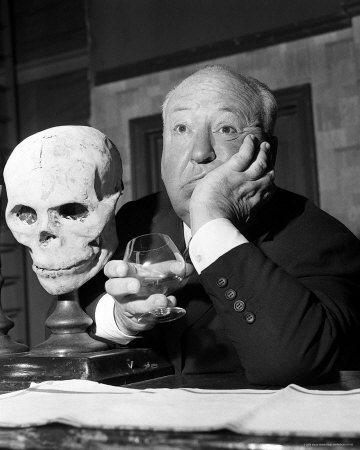Editor’s Note: In this installment of Forgotten Flix’s Top 10 we are honored to have Ken Mogg, one of the world’s foremost authorities on Alfred Hitchcock‘s work, contribute a list of what he considers the “juiciest” Hitchcock films of all time. Many of Hitchcock’s early films are in the public domain so we’ve included the full movie here if they are available. (If they aren’t then we just included the trailer.) Hitchcock fan or not, take two big leaps in your cinematic edification by watching some of these amazing classics.
Reader, make what you will of our heading – I’m happy to take it as a Halloween invitation to share some of my favourite Hitchcocks. (Thanks there, Jason and Joel!) For each film I’ll try to provide some worthy snippet of information, beginning with Mr. Hitchcock’s first film as a director, shot in Munich, Germany.
1. The Pleasure Garden (1925)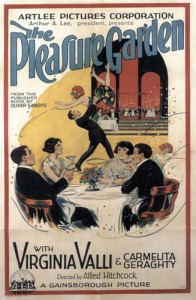
Watch for the British Film Institute release of this – they’ve started collating five different extant prints. It’s the story of two chorus girls. When Jill, just up from the country, has her purse stolen at the stage door, spot the symbolism that Hitchcock would use again, e.g., in Marnie (1964).
 2. The Ring (1927)
2. The Ring (1927)
Back home in England – but clearly having seen E.A. Dupont’s Vaudeville (1925) – Hitchcock was already refining his favourite themes. In this boxing picture, the life- lesson is again “be happy in your league, preferably with a loving wife” (who may have to first learn a lesson or two herself).
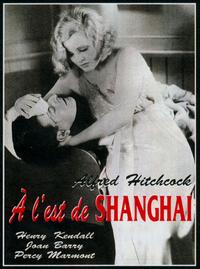 3. Rich and Strange (1932)
3. Rich and Strange (1932)
(also known as East of Shanghai) Another cautionary tale, originally written as a novel by an intrepid Aussie yachtsman, Dale Collins, who apparently met with Hitch. A plain English couple go around the world, behave foolishly, and get shipwrecked. The risqué scene in the tropics where a native girl swims between Fred’s legs is in the novel and was going to be in the film – but the English climate intervened. Too many goose bumps for the actors’ comfort that day!
 4. The 39 Steps (1935)
4. The 39 Steps (1935)
Sometimes it seemed Hitch would do practically anything, probably inspired by G.K. Chesterton (author of Manalive – note that title). Especially for his art. Scholar Brian McFarlane was told that to elicit a startled look from actress Madeleine Carroll the director resorted to ‘flashing’ her. Actually, there’s a line – ‘These men move quickly’ – that sets the spirit of Steps at the outset. It’s all about ‘quickening’, coming alive.
 5. Rebecca (1940)
5. Rebecca (1940)
Lustrous and rich. Hitchcock’s first Hollywood film and arguably his best. Tells two stories simultaneously – the obvious one and the ‘other’ one, expressive of author Daphne du Maurier’s secret admiration for Rebecca.
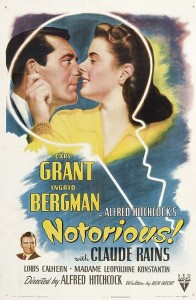
6. Notorious (1946)
Sultry and suspenseful all the way. Fittingly, it has the most protracted screen kiss, between the spy with something to prove, Alicia (Ingrid Bergman), and her prudish minder, Devlin (Cary Grant). Before the end, though, both must venture into ‘unofficial’ territory. (Note. A different matter. The longest – uninterrupted – screen kiss occurs in Lewis Seiler’s You’re in the Army Now, 1941, clocked by Leonard Maltin at 3 minutes, 5 seconds.)
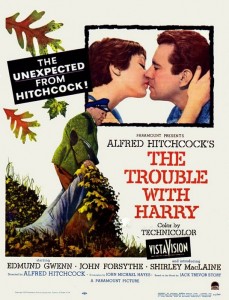 7. The Trouble With Harry (1955)
7. The Trouble With Harry (1955)
Definitely in the spirit of Chesterton. An autumnal parable. A group of people bond together, thanks to a dead body, and again ‘officialdom’ is the butt of the joke (here, Deputy Sheriff Calvin Wiggs). Bring to this an open mind – open to both the ‘pastoral’ mood (optimistic) and the ‘absurdist’ comedy (potentially pessimistic, making fun of our normal seriousness). Hmm. I love what Alma Hitchcock said of her husband in 1960: ‘he has the most completely balanced mind I have ever known and … a talent for total objectivity’.
*Editor’s note: Yes that is really Jerry “The Beaver” Mathers!
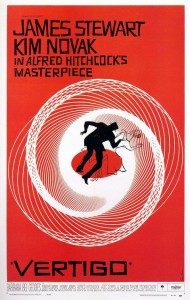 8. Vertigo (1958)
8. Vertigo (1958)
Great, yet needed films like Rebecca and The Trouble With Harry (and William Dieterle’s Portrait of Jennie, 1948) as ground breakers. San Francisco ex-cop Scottie (James Stewart) is the worthy tracker of a sublime idea, embodied by ‘Madeleine’ (Kim Novak), or is he a misguided sensualist, in thrall to his own narrow subjectivity, who can’t see the forest for the Sequoias? On hand to point the lesson at the end is the ambiguous nun – but which lesson? She is both sinister and God’s emissary, bestowing mercy. Choose your vertigo!
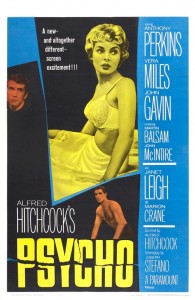 9. Psycho (1960)
9. Psycho (1960)
Like Vertigo, a ‘big lie’ film. Ingeniously scary. Don’t let all the pretentious analyses obscure that fact. If you’ve studied it once too often, maybe look at William Castle’s copycat Homicidal (1961) – which, despite its crudities, can still manage to evoke some of the original terror. Makes you appreciate Hitchcock’s own basic craftiness.
 10. Family Plot (1975)
10. Family Plot (1975)
Has just the right tone for a valedictory film, a gentle comedy suspenser. If a part of Hitchcock once scorned the ‘moron millions’, here he clearly appreciates the little guys – represented by Blanche and George – and their absolute right to happiness. He saw similarities between the medium Blanche and Noel Coward’s Madame Arcati in Blithe Spirit. Really, it’s the ‘all the world’s a stage’ theme of The Pleasure Garden, et al., all over again. A big bad world, but to make what we can of.
___________________________________________
Ken Mogg has contributed to numerous books, articles, and papers on Alfred Hitchcock including a full profile of the director on Senses of Cinema, and, coming soon, an article in the UK academic journal ‘Clues.’ Ken used to teach Hitchcock to budding college filmmakers in Melbourne, Australia. Ken would also like to add that he was completely disheartened by Australia’s miserable defeat in the T20 cricket semi-final against the West Indies [in October].

